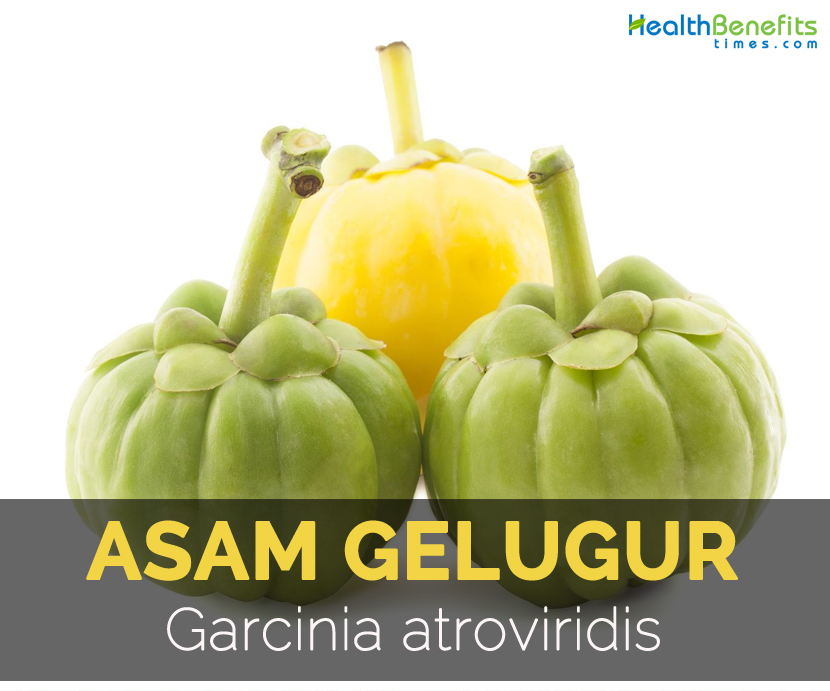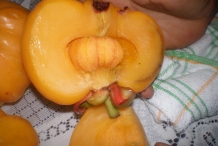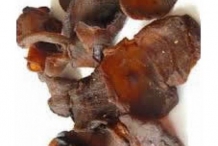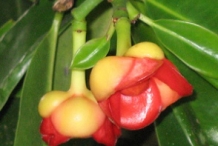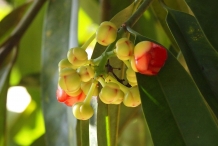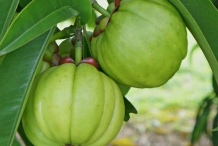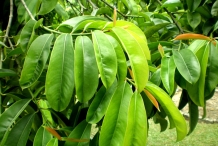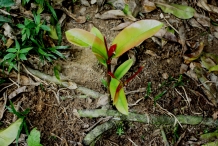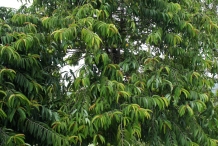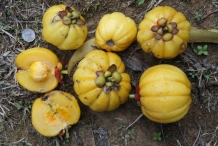Traditionally, it is used to treat various health ailments such as earache, coughs, enhance blood circulation, acne, lower cholesterol and treats high blood pressure. Young leafy shoots, leaves and fruits are edible. The fruits are dried for the later use or also used as an ingredient in various dishes. Due to the sour taste of fruits, it is not usually consumed raw.
History
Though Asam gelugur is inherent to Peninsular Malaysia, Myanmar, Thailand and India, it is widely cultivated in Myanmar and Southern Thailand. It is a tropical species which appears as individual trees in humid and mixed lowland forest on plains and 600 m in highlands of high rainfall areas in Southeast Asia.
Plant
Asam gelugur is a plant having a perennial lifecycle and usually grow up to 20 m tall. The plant bears dark red flowers which is 4-5 cm wide. The fruits are round which borne singly on a twig ends. The fruits are heavy, longitudinally grooved by 12-16 and flattened at apex having a 7-10 cm as a diameter. The flesh inside the fruit is yellow with a firm texture and sour taste. The skin of the fruit is smooth and thin. The pulp possesses several flattened seeds of 1.5 cm long. The shiny dark green leaves are elliptic or oblong, narrow with pointed tip & upturned edges which is up to 20(-30) cm x 6(-7.5) cm in size.
Health Benefits of Asam gelugur
Besides its sour taste, it possesses antioxidant properties and various beneficial flavonoids. It is used as a laxative and expectorant. It helps to absorb the excess fat. The study shows that the extracts possess anti-obesity, anti-diabetes, antiulcerogenic, antifungal, antimicrobial, antioxidant, anti-inflammatory and antitumor activities. It is mostly used for its health and economic benefits. It is also widely popular for the culinary purposes.
- Source of antioxidants
Fruit extracts of G. parvifolia displayed a natural source of antioxidants as well as acetylcholinesterase inhibitor representative with adequate amount of flavonoid and phenolic content. The use of this fruit provides various health benefits to the public because it acquire various antioxidant as well as anticholinesterase properties. It could be used as an effective treatment for Alzheimer’s disease. (1)
- Prevent tumor
The ester derivatives of Garcinia acid such as 1′,1′′-dibutyl methyl hydroxycitrate and 2-(butoxycarbonylmethyl)-3-butoxycarbonyl-2-hydroxy-3-propanolide are found in the fruit of Farcinia atroviridis. The second compound has antitumor activity but both of the compounds not yet poisonous adjacent to the cells and brine ship is an antioxidant. The second one compound as well as the related structures is considered as noncytotoxic chemopreventive agent. (2)
- Weight loss supplement
RCTs show that the extracts of Garcinia show the weight loss for a short period. The magnitude effect is still limited. The effect is not mathematically important and scientific application is uncertain. The future trials must be more accurate, better reported and lengthy. (3)
Traditional uses
- In Thai medicine, it is used as an acidic fruit to reduce weight as well as excess fat.
- The leaf decoction is traditionally used to treat earache.
- The plant possesses anti-inflammatory properties and also used to treat acne.
- Traditionally, the decoction made from Asam gelugur is used to enhance the blood circulation, lower cholesterol and treats high blood pressure.
- Dried fruits are used to improve blood circulation and used as an expectorant for curing coughs.
- The fruit extract is used to lower the level of cholesterol and enlarge the blood vessels.
Precautions
- Do not consume in excess amounts.
- Those who are allergic to Asam gelugur should stay away from it.
How to Eat
- Dried ripe fruits are used in curries and also stewed in sugar and consumed.
- This acid fruit gives acidity to the cooked dishes.
- The fruits are used in curries and used as a sour relish.
- The dried fruit slices are used to give acidity to cooked dishes.
- The dried rind is used in the herbal health teas.
- It could be found in the form of Som-khaek tea, Som-khaek capsules and Som-khaek fruit.
- Young leafy shoots and leaves are consumed fresh.
- In Malaysia, it is cooked as ulam or as sour relish.
- It is usually used as an ingredient in soup and curries.
References:
http://www.dweckdata.com/research_files/garcinia_atroviridis.pdf
http://www.dweckdata.com/research_files/garcinia_atroviridis.pdf
http://tropicalfruitfarm.com.my/pdf/Asam-Gelugor-K-fruit.pdf
http://link.springer.com/chapter/10.1007/978-94-007-1764-0_3#page-2
https://en.wikipedia.org/wiki/Garcinia_atroviridis
Comments
| Asam gelugur Quick Facts | |
|---|---|
| Name: | Asam gelugur |
| Scientific Name: | Garcinia atroviridis |
| Origin | Native to Peninsular Malaysia, Myanmar, Thailand and India. It is widely cultivated in Myanmar and Southern Thailand. |
| Colors | Yellow-orange (Fruit) |
| Shapes | Round; Diameter: 7-10 cm (Fruit) |
| Flesh colors | Yellow, sour, firm |
| Taste | Sour |
| Health benefits | Source of antioxidants, Prevent tumor, Weight loss supplement |
| More facts about Asam gelugur | |
| Rank | Scientific Name & (Common Name) |
|---|---|
| Kingdom | Plantae (Plants) |
| Phylum | Spermatophyta |
| Subphylum | Angiospermae |
| Order | Theales |
| Family | Clusiaceae |
| Genus | Garcinia |
| Species | Garcinia atroviridis |
| Class | Dicotyledonae |


